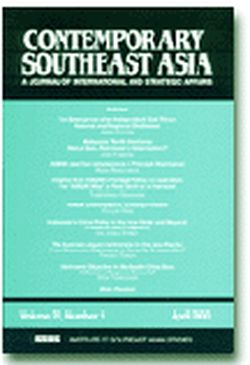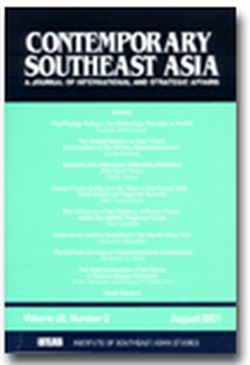Contemporary Southeast Asia: A Journal of International and Strategic Affairs Vol. 27/1 (Apr 2005)

Date of publication:
April 2005
Number of pages:
162
Code:
CS27/1
Contents
-
Contemporary Southeast Asia: A Journal of International and Strategic Affairs Vol. 27/1 (Apr 2005)
-
Preliminary pages
- ARTICLES
-
The Five Power Defense Arrangements: Southeast Asia's Unknown Regional Security Organization, by William Tow, author see abstractThis article traces the evolution of the Five Power Defense Arrangements (FPDA) since its establishment in 1971 to the present day. It describes in detail the evolution of the FPDA's three main pillars: the Integrated Area Defense System (IADS), the architecture for political-military dialogue, and the exercise program. In addition, the article tries to place the FPDA in the context of the security roles played by ASEAN, the ARF, intra-regional bilateral military ties, and the defense relationship with United States. It argues that, while the FPDA's role in upholding regional security cannot be equated to the military contribution of the United States, and the grouping certainly faces significant challenges, it nevertheless contributes positively and innovatively to the ability of Malaysia and Singapore to address not only conventional threats, but increasingly asymmetric and non-conventional security challenges as well, thereby contributing to the overall maintenance of regional security.
-
Unrest in South Thailand: Contours, Causes, and Consequences since 2001, by Aurel Croissant, author see abstractIn the past three years, southern Thailand has seen a rise of ethnic-based violence in its southernmost provinces. The principle objective of this article is to examine contours, causes and consequences of this recent development. The main argument is that although several contentious religious, cultural, economic and political issues lie at the root of ethnic violence, the drift toward militancy in the past three years must be explained by other factors. Historical concerns, religious differences and social and economic marginalization cause local grievances and a latent crisis in inter-ethnic relations in south Thailand. Nonetheless recent Islamization of Muslim minority identity, policy failures of the sitting government and low quality conflict management account more for the increased violence in recent years. These factors created changes in the enabling environment that are allowing insurgency in south Thailand to grow. While the overall assessment for conflict resolution in the short-term is negative, the political fallout of the unrest may strike the already faltering democratic consolidation a heavy blow.
-
The Politics of Locality and Temporality in the 2004 Malaysian Parliamentary Elections, by Vejai Balasubramaniam, author see abstractThis article examines the role of locality (ethnic composition of the constituency) and temporality (the almost five-year hiatus between elections) for BN in the parliamentary elections. In the 2004 Malaysian parliamentary elections, the ruling coalition, Barisan Nasional (National Front, BN), secured a two-thirds majority. BN also increased both its share of popular votes as well as the total number of seats in bumiputera majority constituencies, recovering ground lost in the 1999 elections. In bumiputera minority constituencies where voter sentiment was divided symmetrically between BN and the Democratic Action Party (DAP) it is the latter which has been more successful. It is in the mixed constituencies where BN has been most popular. It concludes that the increase in the number of seats in this category of electorate has worked overwhelmingly to BNs advantage, enabling it to control nearly 90 per cent of the 219-seat parliament, implying therefore a continuation of NEP (New Economic Policy) trends in Malaysia's political economy.
-
The 2004 Ba'Kelalan By-election in Sarawak, East Malaysia: The Lunbawang Factor and Whither Representative Democracy in Malaysia, by Arnold Puyok, author see abstractIn Malaysia, democracy is loosely interpreted in electoral terms where the people have the opportunity, however undemocratic, to cast their votes in electing political leaders in a manner that systemically favours the main ruling party UMNO (United Malays National Organisation) and its alliances under the BN (Barisan National/National Front) umbrella. Arguably, the electoral system that Malaysia currently adopts has denied the ordinary people of their rights to elect their preferred representatives and also contributes to the gradual absence of the democratic process in the Malaysian elections. The Ba'kelalan by-election reflects the above predicament. This article argues that due to the unsystematic conduct of the by-election and the manner in which the candidate replacing the incumbent was selected, the peoples democratic rights have once again been denied amidst the new administrations call for the creation of a civil society based on the principles of good governance and transparency.
-
The 2004 Philippine Elections: Political Change in an Illiberal Democracy, by John L Linantud, author see abstractThis article, based on an analysis of the 2004 elections, argues that illiberal democracy in the Philippines rests on strong foundations. On one hand, bad government, armed men, and the mainstreaming of military activism and People Power have deepened the illiberal strain of political culture since the ouster of strongman Ferdinand Marcos in 1986. On the other hand, the reassertion of democratic nationalism by prominent institutions and public opinion, and new technologies and types of representation, have reinforced a democracy that rests on relatively solid footing even though it may often appear on the brink of collapse. Public religion illustrates the complexity of these issues. If one defines liberal as seeking to change the status quo, the Catholic Church has become one of the country's most liberal institutions because it has challenged a frequently abusive and kleptocratic state for secure elections and basic rights.
-
Multilateralism in China's ASEAN Policy: Its Evolution, Characteristics, and Aspiration, by Kuik Cheng-Chwee, author see abstractThis article aims to study the origins and patterns of China's involvement in regional multilateral institutions, as well as its characteristics and implications for China's ASEAN policy in the post-Cold War era. To this end, the study focuses on China's participation in three ASEAN-initiated and -driven multilateral institutions, namely the ASEAN Regional Forum (ARF), ASEAN-China cooperation, and the ASEAN Plus Three (APT) process. The article shows that China's perceptions and policies toward multilateral institutions have been going through significant changes, from caution and suspicion to optimism and enthusiasm. Instead of perceiving multilateral institutions as malign arrangements that might be used by other states to challenge China's national sovereignty and to limit its strategic choices, Beijing now views multilateral institutions as useful diplomatic platforms that can be utilized to advance its own foreign policy objectives. Such perceptual changes have slowly but significantly led to a greater emphasis on multilateral diplomacy in China's ASEAN policy. It can be argued that multilateralism now plays a complementary, rather than a supplementary role to bilateralism in the conduct of Chinese foreign policy towards ASEAN in the new era.
-
The Relevance of the ASEAN Regional Forum (ARF) for Regional Security in the Asia-Pacific, by Dominik Heller, author see abstractThis article discusses the structure and the functioning of the ASEAN Regional Forum (ARF) and then proceeds to analyze ARF's achievements, expectations, as well as increasing perceptions of its irrelevance from the perspective of a security institution. It suggests that any analysis of the relevance of the ARF first has to examine whether the interests of its central members are opposed to the ARF agenda and raison d'etre. The three most powerful national actors (the United States, China, and Japan) and the Association of Southeast Asian Nations (ASEAN) all have an interest in supporting the ARF. It argues that the ARF is a forum that reflects the convergence of strategic interests of both the regional and external actors. Nevertheless, it concludes with the observation that the effects of the ARF are surely not sufficient to fully secure peace and stability in the Asia-Pacific, but it is arguable whether any form of institution could satisfy this goal.
- BOOK REVIEWS
-
BOOK REVIEW: Terrorism and Violence in Southeast Asia: Transnational Challenges to States and Regional Stability. Edited by Paul J Smith, by Sidney Jones, author
-
BOOK REVIEW: Making Democracy: Leadership, Class, Gender, and Political Participation in Thailand. By James Ockey, by Surin Maisrikrod, author
-
BOOK REVIEW: West Papua and Indonesia Since Suharto: Independence, Autonomy or Chaos? By Peter King, by Bilveer Singh, author
-
BOOK REVIEW: China: Is Rapid Growth Sustainable? Edited by Ross Garnaut and Ligang Song, by Srikanth Kondapalli, author
-
BOOK REVIEW: Strategic Asia 2004-05 Confronting Terrorism in the Pursuit of Power. Edited by Ashley J Tellis and Michael Wills, by Lam Peng Er, author




